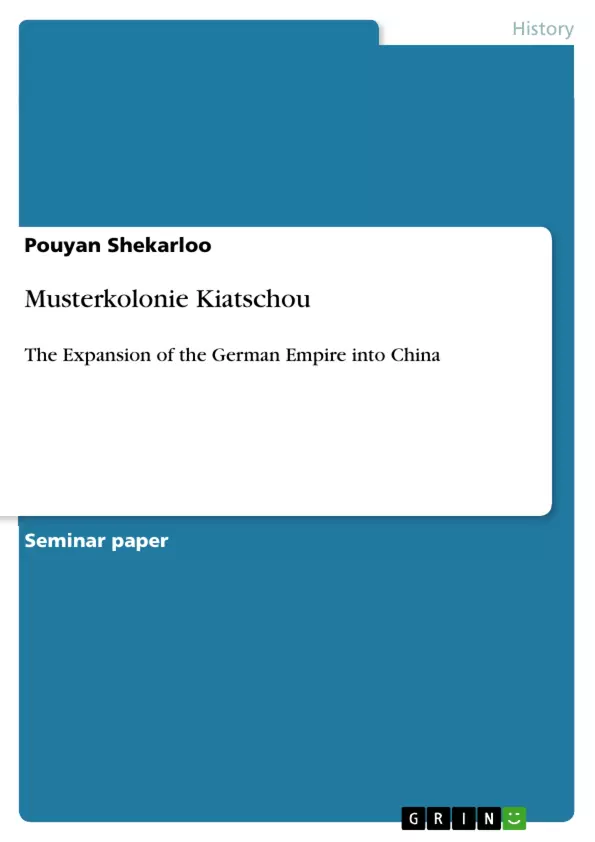On November 14, 1897, German marines seized the bay of Kiautshou, a small territory on the North-Eastern province of China, Shandong. It was a sudden coup, conducted without any prior negotiations or warnings by the German side; however, in the same way it was knocked off and taken away by Japanese troops in 1914. During the seventeen years of German occupation, the German colonial administration under the guidance of the German Imperial Naval Office (Reichsmarineamt), spent huge sums of money and committed great personal efforts to transformed Kiautshou from a rural and underdeveloped area into a modern and prosperous German Model Colony (Musterkolonie). Kiautshou was not thought of to be a settler’s colony but instead it was to become a naval base for Imperial Germany and an economic center for German industry and trade in East Asia. One of the main characteristics of Kiautshou was the idea of a model colony as a mean of representation and propaganda for Germany at home and abroad. The creation of a model colony was intended to demonstrate a specific German colonialism, where careful planning, professional execution, and public supervision were an example for a modern and enlightened imperial policy in contrast to the private and commercial interest led Anglo-Saxon model of imperialism. Therefore, the most advanced means and technologies of the time were applied to make Kiautshou a showcase to the world (“Schaufenster zur Welt”).Schools, hospitals, city planning, railways and mines were established all according to German high standards at home. With time, Qingdao, the actual capital city of Kiautshou, became the “safest and cleanest city in whole East Asia”, with the sixth largest port in China. In this regard Imperial Germany created and implemented a small Germany into China.
Alfred von Tirpitz, Secretary of State of the German Imperial Naval Office, was the leading advocate behind the realization of Kiautshou as a model colony. His name stands also for German naval armament (Flottenrüstung) and the beginning of the second phase of German colonial policy in the 1890s. With the backing of the German Kaiser, Wilhelm II, and the accession of Bernhard von Bülow into office, as Secretary of State of Foreign Affairs, and later German Chancellor (Reichskanzler), he was able to create a massive naval force, which was supposed to be the instrument of what was to become German Weltpolitik.
Inhaltsverzeichnis (Table of Contents)
- Introduction: Kiautshou as a German Model Colony
- I. German Imperialism - The Historical and Theoretical Background
- 1. Bismarck and German Colonial Policy, 1884/85
- 2. Kaiser Wilhelm's Neuer Kurs and the Quest for Weltpolitik, 1890-1896
- II. German Imperialism in China - The Historical Context
- 1. The Prussian East Asia Expedition to China, 1860-1862
- 2. German Missionaries and Merchants in China, 1860-1890
- 3. Shimonoseki and the Seizure of Kiautshou, 1897
- III. "Das Reich der Marine" - Modernization of Kiautshou into a Model Colony
- 1. Establishing a Colonial Administration – State of Law, City Planning, and Land Policy.
- 2. The Development of Qingdao into a Free Port and Economic Center
- 3. German Kulturmission in Qingdao – Education, Science, and Cultural Exchange
- IV. Colonizers and Colonized – German and Chinese Everyday Life in Qingdao
Zielsetzung und Themenschwerpunkte (Objectives and Key Themes)
The purpose of this article is to explore German imperialism in the Wilhelmine era (1890-1914), specifically focusing on German colonial policy towards China with a detailed analysis of Qingdao, Kiautshou, in the Chinese province of Shandong. The article aims to examine the theoretical and historical underpinnings of German imperialism, the implementation of a model colony in Kiautshou, and the everyday life interactions between German colonizers and Chinese inhabitants.
- German imperial and colonial policy in the Wilhelmine era
- The concept and realization of a model colony in Kiautshou
- German-Chinese relations and everyday life in Qingdao
- The role of the German Imperial Naval Office in shaping colonial policy
- The impact of German imperialism on the development of Qingdao
Zusammenfassung der Kapitel (Chapter Summaries)
The first section of the article provides an introduction to the significance of Kiautshou as a German model colony and its role as a naval base and economic hub in East Asia. It highlights the intended purpose of the model colony as a tool for representation and propaganda, contrasting German colonialism with the Anglo-Saxon model.
The second section offers a historical and theoretical background of German imperialism, tracing its origins back to Bismarck’s early colonial endeavors and examining the driving forces behind its expansion under Wilhelm II.
The third section delves into the historical context of German imperialism in China, beginning with the Prussian East Asia Expedition and outlining the growing presence of German missionaries and merchants in the region. It concludes with the seizure of Kiautshou in 1897.
The fourth section explores the modernization of Kiautshou into a model colony, highlighting the establishment of colonial administration, city planning, land policy, economic development, and cultural exchange initiatives.
The fifth section examines the dynamics of everyday life between German colonizers and Chinese inhabitants in Qingdao, providing insights into the complexities of their interactions.
Schlüsselwörter (Keywords)
The article explores German imperialism, colonial policy, model colony, Kiautshou, Qingdao, China, Wilhelmine era, Weltpolitik, German Imperial Naval Office, Alfred von Tirpitz, everyday life, German-Chinese relations, economic development, cultural exchange, and modernization.
- Quote paper
- Pouyan Shekarloo (Author), 2010, Musterkolonie Kiatschou, Munich, GRIN Verlag, https://www.hausarbeiten.de/document/163334


